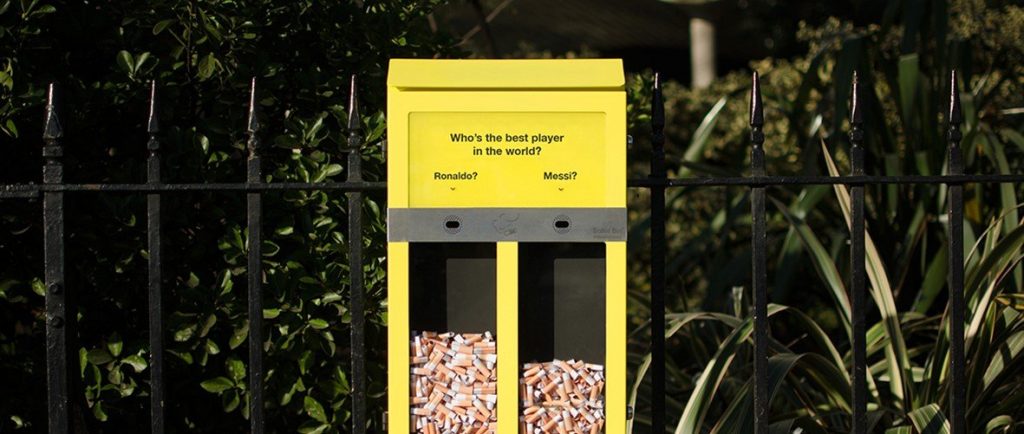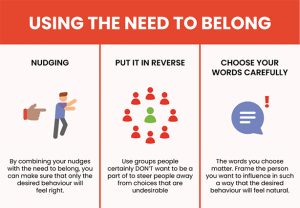How to use ‘the need to belong’ to achieve behavioural change
You probably remember that one time when you were a child and you were not being picked for a team during a game at school. Most likely you felt sad and alone. That’s what we call belongingness: the human emotional need to be accepted as a member of a group. You can use this need to belong as a powerful technique to influence people’s behaviour.
In previous articles, we’ve already written about Tiny Habits, gamification and other psychological tricks to help people change their behaviour for the better. After all, to solve complex problems, you often need to influence human behaviour. In this post, I will explain how you can use the need to belong. But first, let’s look at why this is such a powerful technique to achieve behavioural change.
Intrinsic motivation
In social psychology, the need to belong refers to an intrinsic motivation to connect with others and to be socially accepted. Being part of a group tells us we’re a part of something bigger and more important than ourselves. Intrinsic motivation is a powerful form of motivation when you want to achieve long-term behavioural change. People who are intrinsically motivated won’t need external rewards to do something. They will do it because it is enjoyable and interesting. They don’t need to be pressured to change their behaviour. It comes naturally. When the motivation comes from within, it is way easier to get people to change their behaviour.
Congruent behaviour
The interesting thing about identifying yourself as part of a group is that it influences your decisions. People want to be congruent with their own beliefs. If you see yourself as an athlete, for example, you’re automatically more inclined to favour a salad over an unhealthy snack. It’s simply what someone in your group does.
Nudging
Knowledge about the need to belong and the tendency to act congruently is particularly useful when you design ‘nudges’. Nudges are clever ways of altering people’s behaviour by changing the way choices are presented. Nudging is basically positive manipulation. You stimulate people to make choices that are in their own best interest and in the interest of society. By combining nudges with the need to belong, you can influence the choices they make. Let’s say you want people to stop throwing their cigarettes on the ground. In multiple countries, you can find cigarette boxes in public locations with the question: “Who is the best player in the world? Ronaldo or Messi?” This is a good example of a nudge that uses both gamification and the need to belong. By using your cigarette to cast a vote for Ronaldo, you indicate that you belong to the group that happens to think Ronaldo is the best player in the world. For a smoking Ronaldo-fan, it would feel uncomfortable not using your cigarette butt to vote for your idol.

Hubbub’s ballot bin is a great example of influencing behaviour with the need to belong.
Put it in reverse
You can also use the need to belong the other way around. After all, there are also groups that people really don’t want to belong to. Look, for example, at the way people are nudged to take the stairs in South Korea. In this case, the need to belong is cleverly used to achieve behavioural change. Stickers are applied to the tiles directly in front of the stairs and escalator. One sticker shows a fat person with an arrow pointing to the escalator. The other sticker shows a slim person with an arrow pointing to the stairs. You can imagine why more people will now take the stairs. Nobody wants to belong to ‘the group of fat people’.

Using framing to nudge people towards the stairs and away from the escalator.
Choose your words carefully
Finally, you can stimulate group identity by the way you phrase a question. Stanford psychologist Gregory Walton showed the difference a small change in words can make. In a survey, he asked one half of the people “How important is it to you to be a voter in tomorrow’s election?” The other half got a slight variation of the question: “How important is it to you to vote in tomorrow’s election?” When ‘voter’ (the noun) was used instead of ‘vote’ (the verb), the person who took the survey was more likely to vote the following day. This way of phrasing a question changes your behaviour because it makes you feel like you belong to a specific group; the ‘voters’. For someone who sees herself as a voter, not voting would be incongruous.
In short
If you want to achieve behavioural change, you can use the intrinsic motivation of people to belong to a group. Present the choice in such a way that only the desired behaviour fits the person’s identity.






